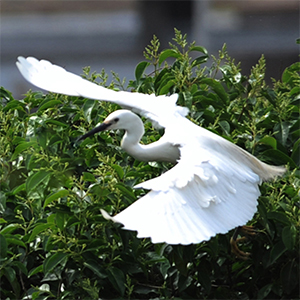
Great Egret
Great egret is the larger one in the egret genus, which has long feather and largesize with a body length of about 90 cm. Great egrets inhabit in seashore, paddy fields, lakes, mangroves and other wetlands. They often stay with other herons and cormorants. Great egret only goes out during the daytime. Its neck shrinks into an S-shape when walking and flying. Its eye rims, lores and bill are black and its bill base is greenish black in breeding period. It has light red gray legs and black feet and toes. Its bill becomes yellow and lores are yellow green in winter plumage period.

Egrets Fly in ZRCC
In summer breeding plumage period, the adult little egret has two long, narrow and soft spear-shaped feathers on itsocciput, which look like double braids.It has yellow green face, black bill, light yellow bill base, black leg and feet, and yellow green toes. It is usually referred to as “egret”. Little egrets inhabit in paddy fields, swamps, ponds and mangroves in coastal shoals. It often bends one foot under its abdomen and stands on anotherone. Little egrets forage during the daytime, and they like to eat small fish, frogs, shrimp and insects. Their breeding period is from March to July. They breed in groups, and often stay with other herons. Both male and female take part in nesting, and often go back to the old nest to repair and reuse in the next year. Its egg is blue-green with a smooth surface. Both male and female incubatethe eggs together. The eggs could be hatched in 23 days.
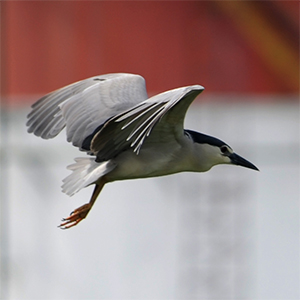
Nycticorax
Nycticorax is one of the few birds with night walking ability. Its upper body is gray black, lower body is white, and its feathers appearwith metallic luster. Young nycticorax’s upper body appears dark brown with light brown streaks and white or brownish white star shaped spots. Its lower body is white and covered with dark brown fine streaks, and its tail is covered with brownish white feathers. Nycticoraxhas blood rediris, black bill, yellow greenlores, and yellow leg, feet and toes.
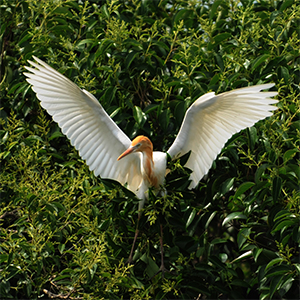
Cattle Egret
Cattle egrethasorange-yellowhead and neck. It is the only egret species that does not eat fish but mainly feeds on spiders, rice field eels, leeches and frogs. Cattle egret is a kind of medium-sized wading bird. When flying, its head shrinks to its back, its neck protruding downward,just like a large laryngeal pouch,and its body is hunchbacked.It also looks like a hunchback when standing. Cattle egret looks fatter than other herons, its bill and neck are also shorter and thicker than other herons.
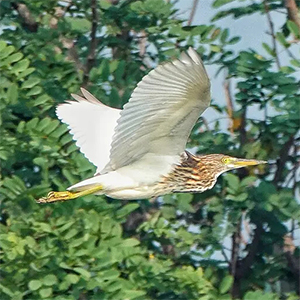
Ardeola Bacchus
Ardeolabacchuslooks fat and its feathers are gray. They like to stay and play in the shallow water of swamps, paddy fields, fish ponds, lakes and rivers, wading in the water for food. In summer plumage, its head, head side, long crest, neck, chest and chest side are millet red, and the feather end is branched. Its crown feather is very long and extends to the back, and the feathers on its back and flat part are also very long, they are lanceolate, black blue and extend to the tail; Its tail is short, round and white. Its beard and throat are white, and there is a white line on the front neck, which extends downward along the front neck from below the lower bill. Its lower neck has long chestnut brown filamentous feathers hanging to the chest. Its abdomen, flanks, axillar, covertsunder wings, covertsunder tail and two wings are all white. In winter plumage, its crown is white with dense brown streaks, its neck is light yellowish white with thick brown streaks, the feathers on back and shoulder are dark yellowish brown and shorter compared with summer plumage, its chest are light yellowish white with dense thick brown streaks.
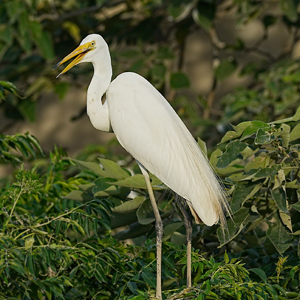
Intermediate Egret(Ardea intermedia)
Intermediate Egret(Ardea intermedia),medium size egret, L 56-72cm; Yellow iris, gape line extends level no more than the eyes, which is one of the distinguishing features from the Great White Egret; Bill black(breeding), bill yellow (non-breeding) with beak yellow; Back and breast with soft and long filamentous feathers.




